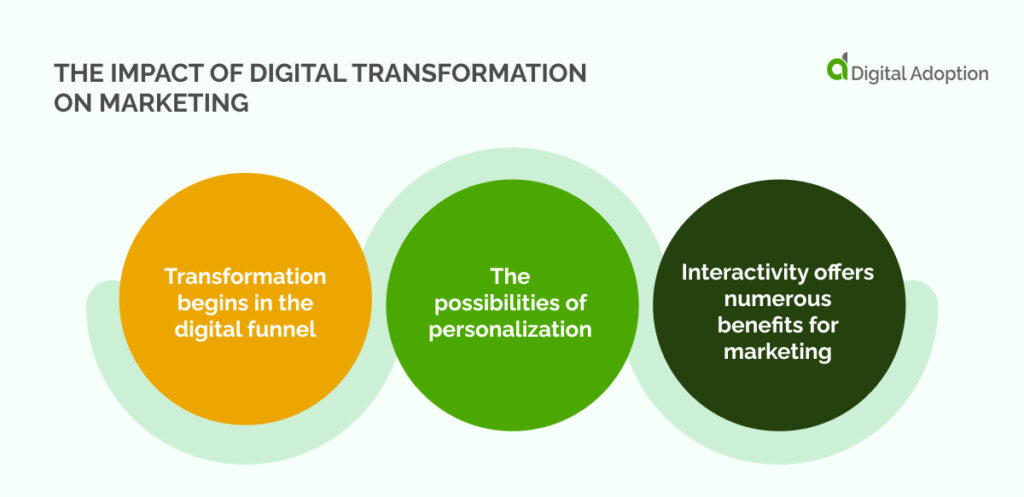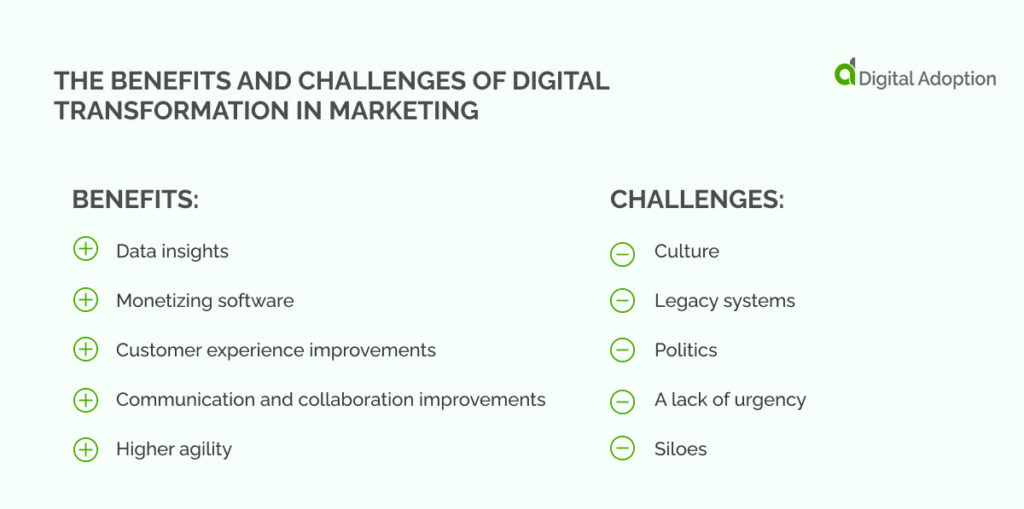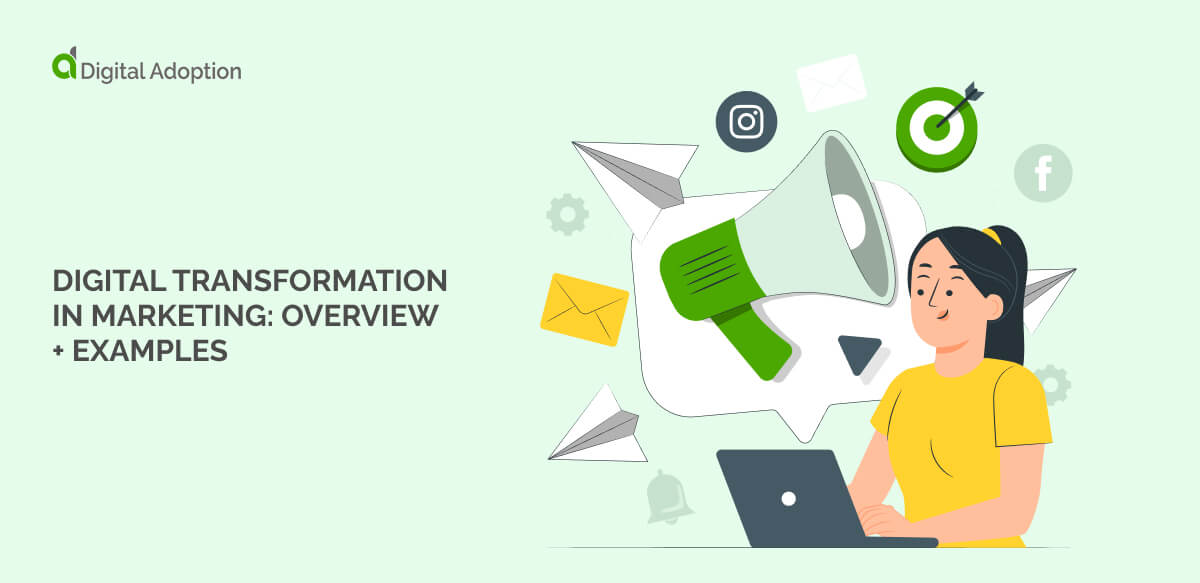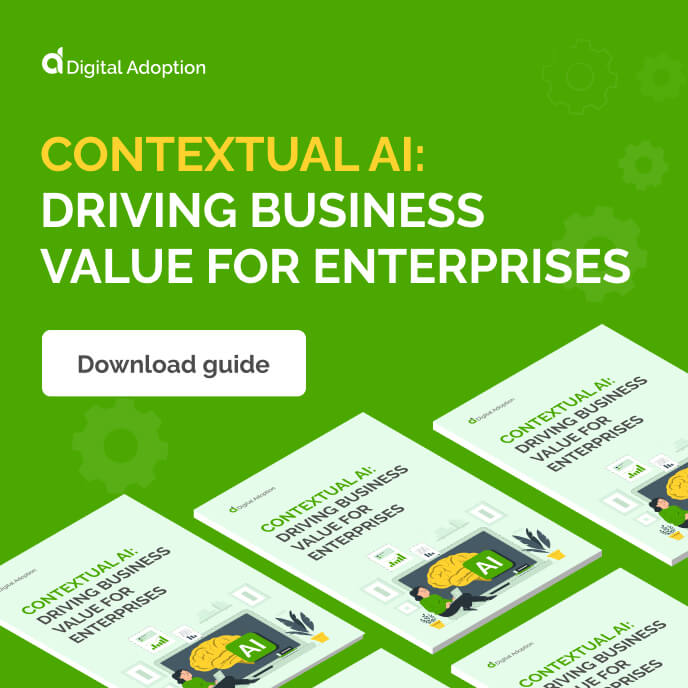A successful digital transformation in marketing depends on two elements: customer data and innovation.
You need to know every detail about your customers’ needs to launch an innovative digital transformation that offers something valuable and new that makes them commit to a sale.
Customers were buying online before COVID-19, but the pandemic caused these purchases to increase by 43% in 2023. The value of e-commerce sales continues to grow and will reach USD 8.034 trillion by 2027.
E-commerce and traditional retail have colossal revenue potential, but to compete with competitors, you will need a successful digital transformation in marketing.
You must engage with the best technologies available to engage with customers. Streaming platforms and social media can become effective digital transformation tools to reach new customers and show them your products, and these should become the focus of your marketing transformation.
To support your transformation journey, we will begin by explaining digital transformation in marketing. We will then move on to its impact, objectives, industry examples, benefits, and challenges.
Explore our expert insights to understand digital transformation in marketing and get creative with your approach to increasing your revenue today.
- What is digital transformation in marketing?
- What are examples of digital transformation in marketing?
- What is the impact of digital transformation on marketing?
- What are the main objectives of digital transformation in marketing?
- What are the benefits of digital transformation in marketing?
- What are the challenges of digital transformation in marketing?
- Get creative with your digital transformation in marketing
What is digital transformation in marketing?
A digital transformation in marketing refers to the shift from digital complacency to the active pursuit of digital excellence through the proper usage and optimization of your digital channels.
Examples look different depending on the organization’s needs. It can involve leveraging existing technologies in new ways, breaking down siloes to promote collaboration, or optimizing the customer experience with the latest technologies.
Whatever your enterprise-scale changes look like, a digital transformation in marketing always seeks to improve the organization with changes to technological approaches.
What are examples of digital transformation in marketing?
Reading examples is the best way to learn how to engage in a successful digital transformation in your marketing department or organization.
The examples below show an enterprise organization successfully implementing a marketing transformation. Each example focuses on one technology each enterprise utilized for success.
Airbnb: User-generated content
Airbnb has emerged as a leader in global accommodations, offering diverse options from Brooklyn apartments to Scottish castles, redefining travel experiences.
A key factor in Airbnb’s success in the competitive lodging market is its innovative approach, which prioritizes customer experience transformation as its main form of marketing.
The company emphasizes user-generated content such as photos, how-to videos, and travel narratives, enhancing its global recognition. They also have strict rules about how users can generate content to ensure fairness and that the organization protects its reputation.
Their social media campaigns inspire wanderlust and exploration, highlighting Airbnb as more than a booking platform.
By sharing authentic stories and images from travelers, Airbnb promotes trust, similar to personal recommendations or reviews, without additional cost.
Leveraging user-generated content, Airbnb maintains a genuine and trustworthy brand image while effectively showcasing its offerings on social media platforms, enhancing its overall marketing impact.
What can you learn from this example?
We can learn several lessons from Airbnb’s transformation, including:
- User-generated content builds trust cheaply: Leveraging user-generated content enhances authenticity, building trust without additional expense for enterprises.
- Customer stories and visuals inspire customers to buy: Airbnb’s focus on customer stories and visuals inspires engagement and loyalty in digital marketing.
- Monitoring feedback is key to marketing transformation success. Monitoring and utilizing online feedback amplifies brand credibility and effectiveness, essential in digital transformations.
Starbucks: Digital flywheel
Starbucks, a globally renowned coffee chain with 32,000 stores across 80 nations, caters to coffee enthusiasts worldwide. Recognizing the advantages of digital transformation, Starbucks launched the ‘Digital Flywheel’ in 2017.
This initiative aimed to revamp rewards, personalization, payments, and ordering based on customer input. Utilizing cloud-based platforms enhanced Starbucks’ capacity to provide recommendations, manage inventory, and streamline production processes.
Incorporating Artificial Intelligence (AI) into its app-enabled Starbucks to personalize product offerings and offer tailored rewards. The CEO emphasizes a commitment to adopting new technologies, solidifying Starbucks’ position as the world’s leading coffee brand.
What can you learn from this example?
We can learn several lessons from Starbucks’ transformation, including:
- Customer-centric approaches win transformations: Starbucks’ Digital Flywheel emphasizes customer-centric transformation, enhancing rewards, personalization, and convenience based on feedback.
- Cloud-based platforms enable efficient operations, inventory management, and personalized customer experiences.
- AI has many uses and benefits for marketing transformations: Integrating artificial intelligence enables tailored recommendations and rewards, driving customer engagement and loyalty.
Audi: Digital showroom
The automotive industry is typically analog, yet AUDI embraced digital transformation, becoming a standout example of success.
In 2012, the company introduced an innovative showroom concept through Audi City. Micro-showrooms in city centers offer access to the entire car catalog, revolutionizing the car discovery and purchasing experience.
Customers can explore and buy cars in city center stores, enhancing accessibility and enjoyment. Audi City hosts forums and exhibitions, bolstering the brand’s presence.
Interactive screens allow advanced car configuration, providing immersive experiences with full-size car images. Customers can use tablets to inspect the interior, view movement, and listen to engine sounds.
Audi City saw a 60% sales increase compared to traditional showrooms. Despite permanently exhibiting only four cars, this yielded significant savings.
What can you learn from this example?
We can learn several lessons from Audi’s transformation, including:
- Enjoyable customer experiences increase sales: Audi’s digital showroom enhances accessibility and enjoyment, revolutionizing the car discovery and purchasing process.
- Interactivity drives conversion rates: Interactive screens and immersive experiences drive customer engagement and sales conversion rates.
- Innovation boosts customer satisfaction: Audi’s approach is innovative. It shows that digital change could greatly raise sales and satisfaction.
Consider how aspects of these success stories could apply to your organization. Could Audi’s digital showroom inspire you? Or does Airbnb’s user-generated content lead you to new ideas? Can it help with your product reviews?
These industry leaders demonstrated their value by always innovating, which drove their success in each transformation. You can do the same to suit your customers and organizational goals.
What is the impact of digital transformation on marketing?

The impact of digital transformation separates into the digital funnel, the possibilities for personalization, and the benefits of interactivity between you and potential customers.
Consider using these points to make the most substantial impact with a digital transformation in your marketing organization or department.
Transformation begins in the digital funnel
Digital transformation first impacts marketing through the funnel, a classic model that outlines the steps potential customers take. These steps form a multi-stage journey culminating in a purchase commitment.
Before digital technologies emerged, the marketing funnel was straightforward and somewhat rigid.
The stages of the sales funnel are:
- Awareness: the stage where consumers first become aware of your product or service.
- Interest: when a shopper investigates further to determine if your business meets their needs.
- Consideration: they begin to take a serious interest in your offerings.
- Intent: When they move towards a decision, they feel the need for your product or service.
- Decision: The point at which a consumer makes a purchase and becomes a customer.
In a pre-digital marketing world, businesses could only produce marketing materials and hope for the best, with interventions possible only if a knowledgeable salesperson engaged directly with potential customers.
Digital transformation has changed this, giving businesses greater control over the process. Marketers now have two invaluable tools: multi-stage interactivity and advanced analytics.
The possibilities of personalization
One of the most significant changes brought by digital transformation in marketing is the ability to personalize content for individual customers.
With metrics and interactivity, businesses can track consumer actions and behaviors individually, using this data to deliver personalized marketing responses.
The beginning is to track a customer’s purchase history and suggest similar products or refills. Metrics from social media platforms like Facebook allow businesses to monitor individual interests, make tailored recommendations, and send personalized emails based on consumer behavior before purchasing.
Marketing experts no longer have to guess where consumer interest lies when they can track it directly on social media.
Interactivity offers numerous benefits for marketing
Digital transformation has dramatically enhanced media interactivity. Unlike traditional media like film, television, and music, digital media gives users more control over what they consume, how they consume it, and with whom they share it.
For example, websites now allow users to choose which information to view and in what order. Social media enables direct interaction with company accounts, allowing users to ask questions and receive responses.
Consumers can also provide feedback on content through likes, thumbs-ups, and comments.
Consider how a digital transformation can impact your organization in all the right ways by using the above aspects.
What are the main objectives of digital transformation in marketing?
Before you begin any transformation using digital approaches, you need to consider the objectives of every transformation in marketing.
Excellent customer experience
The best marketing campaign will fall to its knees if it doesn’t receive support from outstanding customer experience. Enhancing customer experience through personalized, data-driven interactions involves tailoring marketing efforts using the correct customer data used appropriately.
Marketers can deliver more relevant and engaging content by understanding the individual preferences and behaviors of every member of their often diverse customer base.
This approach boosts customer satisfaction and loyalty, increases conversion rates, and promotes a deeper connection between the brand and its audience.
You can also use generative AI for sales as part of your marketing transformations to answer simple customer service tickets.
Increasing operational efficiency
Automating marketing processes enhances operational efficiency by streamlining repetitive tasks like email campaigns, social media posting, and customer segmentation.
When you use automation tools, you can save time and reduce errors to reduce operational costs. Marketers can then focus on what they do best: strategic activities. This efficiency boost results in cost savings, improved productivity, and more effective scaling of marketing efforts.
Optimizing analytics
Leveraging advanced analytics to enhance decision-making and strategy entails utilizing data insights to inform marketing initiatives. You can do this by overhauling how you collect and process data with a data transformation.
By analyzing customer behavior, campaign performance, and market trends, marketers can make informed decisions to optimize outcomes.
This data-driven approach helps identify opportunities, measure effectiveness, and refine strategies for better results and increased return on investment.
Expanding digital channel reach
Want to engage with more customers to increase your revenue? Broadening reach and engagement through digital channels involves utilizing online tools such as social media, email, and content marketing to connect with a broader audience.
These platforms offer real-time interaction and feedback, boosting brand visibility and customer engagement. This approach enables businesses to reach potential customers across various platforms, enhancing brand awareness and driving traffic and conversions.
Innovation and adaptability
Encouraging innovation and adaptability in marketing strategies is vital in a swiftly evolving digital environment. This approach entails keeping abreast of the latest trends, technologies, and consumer behaviors and being open to experimentation and iteration.
Embracing a continual enhancement and flexibility culture empowers marketers to devise creative solutions, swiftly respond to market changes, and sustain a competitive advantage.
What are the benefits of digital transformation in marketing?

While digital transformations unlock marketing success, truly grasping the benefits is crucial.
This empowers you to leverage deeper customer insights, optimize campaigns, and ultimately ignite your marketing transformation journey.
Let’s examine each benefit and learn how to incorporate them for a smooth transformation.
Data insights
Insights derived from numerical data, encompassing user interactions online, are pivotal for businesses. Every click on a website, social media engagement, or smartphone search generates a wealth of data.
This data analysis enables companies to gain valuable insights about their target audience, which helps them innovate and improve user experience.
By using these insights, companies can stay ahead of trends. They can also improve their offerings and build stronger connections with their audience. This benefit will help drive growth and success in the digital landscape.
Monetizing software
Digital transformation offers more benefits. It includes shifting from a product-centric to a software-centric approach. Modern business leaders recognize this shift for its better return on investment.
However, many companies face uncertainty about starting to make money from software. This uncertainty hampers their progress.
Using software management solutions helps monetize software. They are key in digital transformation. By going digital, businesses unlock the full potential of their software. This benefit maximizes revenue. It keeps them competitive in today’s fast-changing digital world.
Customer experience improvements
The main goal of digital transformation is to use technology to improve the experience of customers and employees.
Organizations can customize new software, social media, and apps. They do this to meet user needs, and to simplify tasks and improve efficiency. Operations that were once cumbersome and time-consuming, such as wire transfer requests, are now streamlined through online technologies.
The focus is on using digital tools to make processes easier to use. This action will enrich the experience for both customers and employees.
Communication and collaboration improvements
As businesses expand, communication gets harder. Diverse tools, or lack thereof, often lead to in-person operations, hindering efficiency.
Today’s world is globalized. Traditional communication methods are inadequate. They impede organizations. Enhanced collaboration and seamless communication are imperative for overall productivity and success.
A digital platform is essential. It enables communication and collaboration across internal departments, key to promoting innovation and driving results.
Embracing digital transformation empowers organizations. It helps them to thrive in a changing market. It gives them the agility and efficiency needed for sustained growth and success.
Higher agility
Digital transformation streamlines processes, enabling faster, simpler, and more efficient workflows. Automated digital workflows are tailored for managing information. They free up employees’ time for useful activities and speed up project development.
For instance, feedback processes are consolidated on collaborative platforms. These platforms eliminate the need for multiple emails to proofread documents, and stakeholders can share comments and notes conveniently.
They can do so through a single interface. These enhancements benefit many departments. They span marketing, finance, and customer support. They make operations smoother and improve productivity.
Start a digital transformation in your marketing department or organization. Start it today. You will enjoy all the benefits above.
What are the challenges of digital transformation in marketing?
No business enjoys gains without challenges. Your digital marketing transformations are no different.
Challenges include culture, a lack of urgency, politics, and siloed thinking. They can all delay transformation.
Let’s examine each challenge and learn how to overcome them for a smooth transformation.
Culture
Moving to digital marketing is difficult. This is true in conservative companies. Employees fear change and stick to traditional ads, which stifles innovation and fresh approaches to strategies.
Many organizations see marketing as a cost center, not a source of revenue. They overlook digital marketing’s competitive edge.
People resist change. This resistance stops the use of advanced technologies, such as marketing automation and artificial intelligence, which block valuable data collection and analysis.
Cultural change is possible with support from change agents and leaders. It requires patience and proving digital marketing’s effectiveness through incremental successes.
Pilot programs can help. They enable data collection while saving resources. Leaders must buy in and gradually shift to digital marketing, which is a core business strategy and key to overcoming this obstacle.
Legacy systems
Certain technology systems inevitably become outdated. Marketing innovators constantly seek new tools. They use the tools to improve their marketing stack. The key is to use marketing technology effectively and simply.
To overcome this obstacle, adapt to new tech. Do this by exploring new opportunities. Test free tools to assess their potential fit for your company. Update your old systems. Do this when building new business capabilities.
Manage your technology portfolio carefully. Treat it like your product portfolio. Ensure it stays relevant and effective.
Politics
Nearly every company faces dysfunction. These dysfunctions can include poor leadership, conflicting goals, and power struggles. Most notably, corporate politics are prevalent.
Politics stem from big egos and self-interests. They also come from territory grabs and unclear roles and responsibilities.
These issues can hinder marketing’s transformation. Leadership often controls the pace of change. They view marketing narrowly and lack confidence in its ability to achieve business goals.
Politics is about power and control. Progress is impeded when changes don’t align with the agendas of powerful people.
This sad fact can greatly delay or stop needed marketing and business strategy changes. To overcome this, we must address these political challenges directly. We also need to foster a more collaborative environment.
A lack of urgency
A common obstacle to change is a lack of urgency. The global pandemic created a sense of urgency for adopting new digital technologies. However, employees often struggle to adapt to new ways of working.
The fall of Circuit City shows that success can breed complacency. Complacency risks business failure. Transformation is crucial to prevent this fate.
To overcome this obstacle, see that complacency’s effects are not immediate. They will show up in the long term. Introduce fresh ideas and learn from industry leaders.
Combat routine. Approach each day with a new perspective. Keep seeking innovation and improvement. This approach allows you to stay relevant and competitive.
Siloes
Customers and prospects don’t care about your departments. They expect a seamless experience, and it should be integrated when they interact with your company.
For instance, they must call a phone number or fill out an online form. Every interaction across teams must be consistent and work well.
Digital marketing requires breaking down silos. This scenario happens because it raises the stakes. Every part of marketing and your company must work together. They must do this to provide a great customer experience.
Create one vision for customer experience. Promote collaboration between departments by using common collaboration tools and attending each other’s meetings.
Get creative with your digital transformation in marketing
Marketing is about combining customer knowledge with new approaches. You must do this well to succeed.
When you get creative with your digital marketing, you give new and existing customers new experiences. An innovative culture makes your organization feel fresh, offering something unique.
You can beat challenges. They include siloed thinking and legacy systems. But you can beat them with new practices. To innovate in all digital marketing, prioritize experiments. Embrace new tech, promote creativity, analyze data, and adapt fast to trends.
You will enjoy higher agility levels. You will also see better collaboration and great customer experience. This scenario will happen when you use innovative approaches in your transformations. They will make customers stay loyal to your organization. This benefit will raise your reputation and revenue.




![4 Best AI Chatbots for eCommerce [2025]](https://www.digital-adoption.com/wp-content/uploads/2025/03/4-Best-AI-Chatbots-for-eCommerce-2025-img-300x146.jpg)


![13 Digital Transformation Enablers [2025]](https://www.digital-adoption.com/wp-content/uploads/2025/02/13-Digital-Transformation-Enablers-2025-img-300x146.jpg)



![4 Best AI Chatbots for eCommerce [2025]](https://www.digital-adoption.com/wp-content/uploads/2025/03/4-Best-AI-Chatbots-for-eCommerce-2025-img.jpg)

